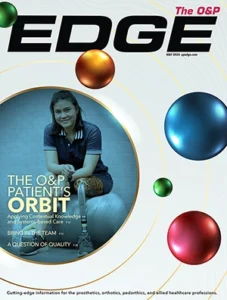The Orthotic and Prosthetic Assistance Fund (OPAF) offers the following information from the National Science Foundation (NSF)
(http://www.nsf.gov/) as a public service announcement (PSA) that helps to fulfill OPAF’s official representation of O&P in community and philanthropic circles. OPAF aims primarily to enable individuals with physical disabilities – especially those served by members of the U.S.
orthotics and prosthetics community – to enjoy the rewards of personal achievement, physical fitness, and social interaction. Complete information about OPAF is available at http://www.opfund.org.
—
NSF Press Release
NSF PR 04-084 – June 16, 2004
Media contact: Elizabeth Malone, NSF (703) 292-7732 [email protected] Program contact: Joan Burrelli, NSF (703) 292-7793 [email protected]
National Science Foundation Releases “Women, Minorities, and Persons with Disabilities in Science and Engineering 2004”
New online report provides easy access, timely updates
ARLINGTON, Va.-According to a new report, Asian/Pacific Islanders living in the United States earn more science or engineering (S&E) bachelor’s degrees than whites earn, relative to their college-age (20-24 year old) peers. Meanwhile, data on blacks, Hispanics, and American Indian/Alaska Natives show steady, although small, increases in the number of S&E bachelor’s degrees earned during the same period.
The new, online report, Women, Minorities, and Persons with Disabilities in Science and Engineering 2004, will allow users to more easily search for data and presentation viewgraphs by education level, employment, and population group. In addition, data for different sections of the web-based report will be updated as new data become available.
Like its predecessors, the 2004 report continues to show differences in the participation of men, women, racial/ethnic groups, and persons with disabilities in both education and employment in scientific and engineering (S&E) fields.
Since 1997, for example, the number of associate and bachelor’s degrees in computer sciences has risen steeply. However, the number of bachelor’s degrees in computer sciences awarded to women dropped from 37 percent in 1985 to 28 percent in 2001.
Women now constitute 41 percent of all S&E graduate students, ranging from a high of 74 percent in psychology to a low of 20 percent in engineering. Almost 70 percent of Asian/Pacific Islander S&E graduate students selected engineering, computer sciences, and biological sciences. In contrast, about one-third of blacks, Hispanics, and American Indian/Alaska Natives and 42 percent of white S&E graduate students selected those fields. Similar percentages of graduate students with and without disabilities enrolled in the broad fields of engineering/computer sciences/mathematics and life/physical sciences, while a higher percentage of students with disabilities than without enrolled in social and behavioral sciences.
In employment, the report shows that wives with S&E doctorates are more likely than counterpart husbands to face the challenges of a dual-career household. More wives with doctorates have a spouse employed full time, and more males than females have a spouse not employed. These findings correspond with those in the recent NSF report, “Gender Differences in the Careers of Academic Scientists and Engineers,” which can be found at http://www.nsf.gov/sbe/srs/nsf04323/start.htm.
The report draws from NSF and other data sources, and provides links to the sources for all data and for further information about specific topics. The website for the report is http://www.nsf.gov/sbe/srs/wmpd/start.htm.
This biennial report from the National Science Foundation (NSF) is mandated by the Science and Engineering Equal Opportunities Act (Public Law 96-516).
-NSF-
The National Science Foundation (NSF) is an independent federal agency that supports fundamental research and education across all fields of science and engineering, with an annual budget of nearly $5.58 billion.
NSF funds reach all 50 states through grants to nearly 2,000 universities and institutions. Each year, NSF receives about 40,000 competitive requests for funding, and makes about 11,000 new funding awards. The NSF also awards over $200 million in professional and service contracts yearly.
Receive official NSF news electronically through the e-mail delivery system, NSFnews. To subscribe, send an e-mail message to [email protected]. In the body of the message, type “subscribe nsfnews” and then type your name. (Ex.: “subscribe nsfnews John Smith”)
Useful NSF Web Sites:
NSF Home Page: http://www.nsf.gov
News Highlights: http://www.nsf.gov/od/lpa
Newsroom: http://www.nsf.gov/od/lpa/news/media/start.htm
Science Statistics: http://www.nsf.gov/sbe/srs/stats.htm
Awards Searches: http://www.fastlane.nsf.gov/a6/A6Start.htm




